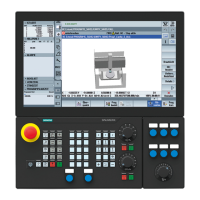Transformations
6.3 Orientation polynomials (PO[angle], PO[coordinate])
Job planning
342 Programming Manual, 07/2010, 6FC5398-2BP40-0BA0
6.3 Orientation polynomials (PO[angle], PO[coordinate])
Function
Irrespective of the polynomial interpolation from G-code group 1 that is currently active, two
different types of orientation polynomial can be programmed up to the 5th degree for a 3-axis
to 5-axis transformation.
1. Polynomials for angles: lead angle LEAD, tilt angle TILT
in relation to the plane that is defined by the start and end orientation.
2. Polynomials for coordinates: XH, YH, ZH of the second curve in space for the tool
orientation of a reference point on the tool.
With a 6-axis transformation, the rotation of rotation vector THT can be programmed with
polynomials up to the 5th degree for rotations of the tool itself, in addition to the tool
orientation.
Syntax
Type 1 orientation polynomials for angles
N… PO[PHI]=(a2, a3, a4, a5)
N… PO[PSI]=(b2, b3, b4, b5)
3-axis to 5-axis transformation
3-axis to 5-axis transformation
Type 2 orientation polynomials for coordinates
N… PO[XH]=(xe, x2, x3, x4, x5)
N… PO[YH]=(ye, y2, y3, y4, y5)
N… PO[ZH]=(ze, z2, z3, z4, z5)
Identifiers for the coordinates of the second
orientation path for tool orientation
In both cases, with 6-axis transformations, a polynomial can also be programmed for the
rotation using
N… PO[THT]=(c2, c3, c4, c5)
or
N… PO[THT]=(d2, d3, d4, d5)
Interpolation of the rotation relative to the
path
Interpolation absolute, relative and
tangential to the change of orientation
of the orientation vector. This is possible if the transformation supports a rotation vector with
an offset that can be programmed and interpolated using the THETA angle of rotation.

